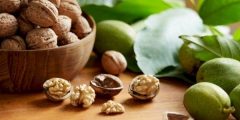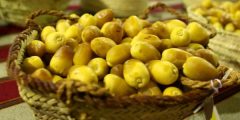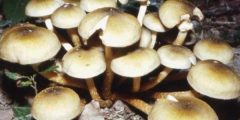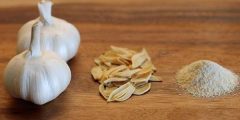Coconut tree classification
The coconut tree, its common name is Coconut Palm, and its scientific name is (Palma de Coco), and its classification is as follows:[XNUMX]
- Kingdom: plants.
- Subkingdom: green plants.
- Family: palm trees.
- Section: Vascular plants.
- Genus: Coconut palm.
- Type: coconut palm.
General description of the shape of a coconut tree
The coconut tree is a type of fruit tree, as it produces edible fruits that contain a transparent white liquid known as coconut water. They are rich in fats. These fruits are eaten fresh or can be dried or processed to obtain coconut oil or coconut milk, which are considered... Nutrient-rich materials.[XNUMX]
The walnut tree produces oval-shaped fruits ranging from 30.48 to 45.72 cm long, and has a thick fibrous peel.[XNUMX] It is followed by a hard shell, inside which is a thick layer of white coconut, containing a transparent liquid.[XNUMX]
Each type of coconut tree has a specific height, but most species reach 24 m. The coconut tree has large, fan-shaped leaves at its end. Coconut trees are also long-living trees, as their lifespan ranges from 60-80 years. year.[XNUMX]
Read also:Types of potatoesThe trunk of the coconut tree is greyish-brown in colour, and eventually ends with green fronds. These fronds grow from a bud located at the top of the tree trunk. The number of fronds present is estimated at approximately 30, and the length of each ranges between 3.96 and 7.0m.[XNUMX]
Coconut tree fruits
A coconut tree often begins producing fruit 5 or 6 years after it was planted, but coconut fruit production will not be good until 12 to 13 years have passed.[XNUMX]
After 12 months have passed from the date of pollination of the flowers, the fruits will mature, and if the tree receives good care, it can produce 50-80 fruits per year. The coconut tree can continue to produce fruits until it reaches the age of 80 years, and it often reaps nuts. India has different times of fruit ripening.[XNUMX]
The harvest time begins when the color of the fruit’s rind becomes brown. The process is carried out by a person climbing the tree and cutting it with a knife, then opening the fruit and eating it directly. Refrigerated coconut fruits can be kept for two months and for two weeks without refrigeration at room temperature.[XNUMX]
Read also:Venus plant
Places of spread and cultivation of the coconut tree
The coconut tree is often grown in tropical regions, and thus it is found in various tropical regions around the world, as well as in the western Pacific and Indian Oceans, as this type of tree prefers areas with warm and humid climates near the coasts between latitudes (26) degrees south. And north.[XNUMX]
It seems that the original homeland of these trees is India, especially the southern states, and India ranks third in terms of the area of land planted with these trees in the world.[XNUMX]
The coconut tree is grown in Indonesia, the Philippines, South Asia, Africa and the Caribbean.[XNUMX] It is also grown in the United States, especially in areas free of cold and frost, and coconut trees prefer to grow in warm areas away from falling temperatures.[XNUMX]
Types of coconut tree
There are approximately 13 types of coconut trees, and these types are as follows:[XNUMX]
- Malaysian yellow dwarf
This species is found in tropical regions in several countries such as; Thailand, Brazil, and Fiji. It is a highly productive tree.
Read also:Venus plant
- Fiji Dwarf
This species is found in the state of Florida in America. It is a short tree but produces many fruits.
- Golden Malay
This type of coconut tree is grown in Bulgaria, and these trees produce very good quality coconuts.
- Coconut king
This species is grown in Sri Lanka as well as in large parts of India. It is shorter than other species, and has a distinctive quality that is clearly evident in the fruits it produces.
- Long West Coast
This type of coconut tree is found in various parts of the world, especially coastal ones, and this type begins to produce fruits 6 to 7 years after planting.
- Makabuno
It is one of the unique species that is characterized by its short length. It is grown in large parts of the continent of Asia, and its fruits often have a soft texture and distinctive taste.
- Tall trees of Panama
It is a species that grows in harsh and difficult conditions such as; High winds and storms, and it is resistant to drops in temperature.
- Maybane trees
This type of coconut tree is grown in Jamaica, and it can also be found in Latin America and Florida, and it is a hybrid tree.
- VHC1 trees
It is a large species with high productivity, as it begins producing fruits 4 years after planting.
- East Coast tree
This type of coconut tree produces approximately 70 fruits per year, and is extremely rich in oils.
- Tiptur Al-Tawil
This type of coconut tree produces approximately 70 to 80 fruits during one year, and it is one of the types that does not require a lot of care.
- Orange dwarf
It is a fairly tall tree, and its age can reach 40 years. It begins to produce fruits after 3-4 years, and its fruits are of good quality.
- Green dwarf
This type of coconut tree produces approximately 60-70 fruits, and begins production after 3-4 years.
How to grow a coconut tree
The process of planting a coconut tree requires some important steps in order to obtain satisfactory results and achieve the desired goal of planting it. These steps are:
Soil preparation and coconut planting
Prepare the soil for planting a coconut tree through the following steps:[XNUMX]
- Prepare the land before starting the planting process by choosing a sunny area with loose sandy soil.
- Choose the planting land so that it is free of large trees, as they often consume a lot of nutrients and water in the soil.
- Dig a suitable hole for the coconut seedling. The depth of the hole is often the height of the pot of the plant or seedling to be planted.
- Use a little fertilizer during the planting process, as it helps stimulate the plant’s roots to grow well.
Coconut tree cultivation
The process of planting a coconut tree begins by following the following:[XNUMX]
- Plant the plant in the center of the hole, then fill in around it to stabilize the tree. Natural fertilizer can also be used during this process.
- Wait for at least 6 to 10 years for the tree to start producing fruits, as coconut trees grow very slowly.
Coconut tree care
The coconut tree should receive the necessary care by doing the following:
- Water the coconut tree once a week, if it does not receive good and sufficient rain.
- Make sure to fertilize the tree with fertilizers containing potassium, nitrogen, and manganese. The fertilization process must be done regularly, every 2 to 3 months.
- Monitor the tree constantly throughout the growth period, as it may become infected with some diseases, especially the disease that causes yellowing of its leaves.
Benefits of coconut tree
Each part of the coconut tree has a set of great benefits, which are as follows:
Benefits of coconut fruits
Coconut fruits contain a white substance called flesh, which is sweet in taste. It can be eaten fresh or dried, and contains many benefits, including the following:[13]
- Promote heart health.
- Weight loss.
- Improve digestive health.
- Maintaining blood sugar.
- Improve immunity and reduce inflammation.
- Strengthen memory.
Benefits of coconut oil
Coconut oil has many benefits, perhaps the most important of which are the following:[14]
- A cooking ingredient that has many health benefits.
- Antioxidant and improves skin and hair.
- Antimicrobial.
- Burn body fat.
- Fast source of energy.
- Use it in some recipes to reduce the feeling of hunger.
Coconut water benefits
Coconut water is the pure water found inside the fruit. This water has a sweet taste and is low in sugar and calories. It has many benefits, including the following:[XNUMX]
- It contains many nutrients such as; Potassium, sodium, and magnesium.
- It is used to clean the skin, as it helps fight acne.
- It retains body moisture and is low in fat and cholesterol.









